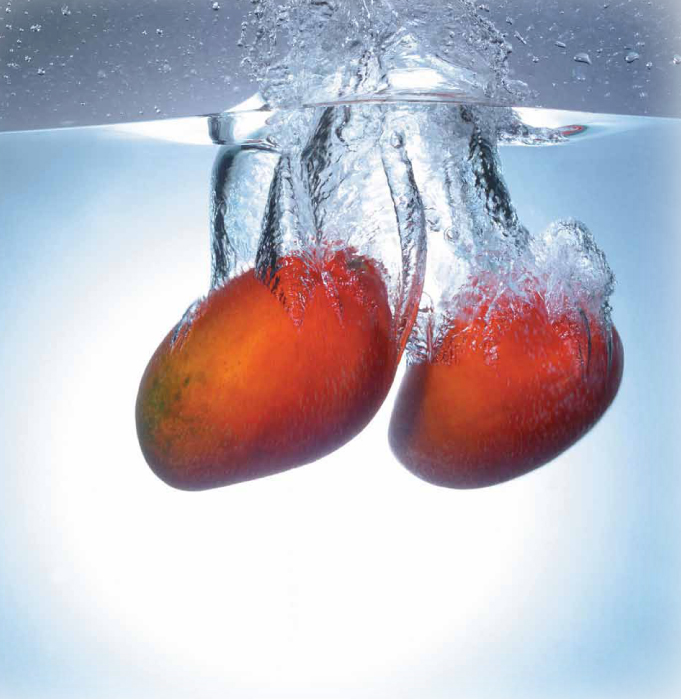Mango is widely known as the “king of fruit” — and there is good reason for its veneration. Mango is regarded as a valuable item of diet and a household remedy. It is rich in amino acids, vitamin C and E, flavonoids, beta carotene, niacin, calcium, iron, magnesium and potassium.
About 6,000 years ago, the wild mango originated in the foothills of the Himalayas of India and Burma. Amazingly, about half of these trees still grow in India and Southeast Asia. Also known as Mangifera Indica, , this exotic fruit belongs to the family of Anacardiaceae. Though native to Southern and Southeast Asia, the fruit is also grown in Central and South America, the Caribbean, Africa and the Arabian Peninsula. Today, there are over 1,000 different varieties of mangos throughout the world.
Here are the five health and nutrition benefits for eating mangos:
Anti-Cancer: The phenols in mangos, such as quercetin, isoquercitrin, astragalin, fisetin, gallic acid and methylgallat, as well as the abundant enzymes, have cancer-preventing capacities. Mango is also high in a soluble dietary fiber know as pectin. Research identifies a strong link between eating lots of fiber and a lower risk of cancers of the gastrointestinal tract. A cup of sliced mangos (around 165 grams) contains 76% of the needed daily value of vitamin C, a potent antioxidant, which helps protect cells from free radical damage and reduces the risk of cancer.
Eye Health: One cup of sliced mangos sup plies 25% of the needed daily value of vitamin A, which promotes good eyesight. Eating mangos regularly prevents blindness, refractive errors, dryness of the eyes, softening of the cornea, itching and burning in the eyes.
Helps In Digestion: Mangos contain digestive enzymes that help break down proteins and aid digestion. It is also valuable to combat acidity and poor digestion because of an enzyme found in the fruit that soothes the stomach. Due to the high amounts of fiber found in mango, it can be helpful in keeping you regular, thereby preventing constipation. In India, a decoction of the mango peel is given to people with inflammation of the stomach mucus membranes. Eating one or two small tender mangos in which the seed is not fully formed with salt and honey is found to be very effective medicine for diarrhea, morning sickness and indigestion.
Benefits To Skin: Mango is effective in relieving clogged pores of the skin. What this means is that people who suffer from acne, which is caused by clogged pores, will benefit from mango. Just remove the mango pulp and apply it on your skin for about 10 minutes before washing it. Eating mango regularly makes the complexion fair and the skin soft and shining.
Beneficial For Anemia: Mangos are beneficial for pregnant women and individuals suffering from anemia because of their iron content. Also, vitamin C in the mango enhances the absorption of iron vegetable food like rice. Many women after menopause become weak and should eat mangos and other fruits rich in iron.
Remember, mangos can be eaten both raw and ripe. They are a wonderful source of vitamins and minerals essential for the human body. Make an effort to include mangos in your daily diet as this can benefit your health more than your usual non-fiber diet.
Speaking of great ways to include mango in your diet, make the most of the mahi mahi’s great flavor by pairing it with a fruit salsa made from olive oil, mango, mango nectar, onion, cilantro and lemon peel.
Fish with Mango Salsa
Makes 6 to 8 servings
Ingredients
• 2 tablespoons soy sauce
• 5 tablespoons lemon juice
• 2 cloves garlic, minced
• 2—2 ½ pounds skinned, boned mahi mahi fillets
• teaspoon olive oil
• onion (about 6 oz.), chopped
• ½ cup refrigerated or canned mango nectar
• ripe mango (about 1 lb.), peeled, pitted and coarsely chopped
• 3 tablespoons chopped fresh cilantro
• teaspoon finely shredded lemon peel
Preparation
1. Mix soy sauce, 2 tablespoons lemon juice and half the garlic.
2. Cut fish into 6 or 8 equal pieces, then rinse and pat dry. Rub soy mixture all over fish. If making ahead, cover and chill up to 30 minutes.
3. In an 8 to 10-inch frying pan over high heat, combine oil, onion and remaining garlic. Stir until onion begins to get limp, about 2 minutes. Add mango nectar and 3 tablespoons lemon juice; stir until boiling.
4. Remove onion mixture from heat. Stir in mango, cilantro, and lemon peel. Use hot or cool.
5. Arrange fish pieces, side by side, in a wire grilling basket. Close basket and lay it on a barbecue grill over a solid bed of hot coals or high heat on a gas grill. (You can hold your hand at grill level only 2 to 3 seconds.) Close lid on a gas grill.
6. Cook fish, turning once, until it is barely opaque and still moist-looking in thickest part (cut to test), 8 to 10 minutes total.
7. Serve with salsa and lemon juice.
Kitchen Notes
A hinged wire grilling basket makes the fish easier to handle. Otherwise, cook fish on a lightly oiled grill.


